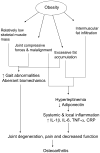Obesity and weight loss in the treatment and prevention of osteoarthritis
- PMID: 22632704
- PMCID: PMC3623013
- DOI: 10.1016/j.pmrj.2012.01.005
Obesity and weight loss in the treatment and prevention of osteoarthritis
Abstract
Obesity is associated with an increasing prevalence of musculoskeletal complaints and pain. Obesity is a major risk factor for osteoarthritis (OA), and pain can manifest in load-bearing and nonload-bearing joints. The lumbar spine and the knee are 2 primary sites for pain onset in the obese patient. Irrespective of the weight loss method, reduction of body fat can lower the mechanical and inflammatory stressors that contribute to OA. Single or combined methods of weight loss including exercise, dietary modification, medications, and bariatric surgery are associated with lower joint pain and increased physical function. Methods of weight loss or maintenance in early years may reduce the life exposure of joints to the obesity induced stressors on load bearing joints.
Copyright © 2012 American Academy of Physical Medicine and Rehabilitation. Published by Elsevier Inc. All rights reserved.
Figures
References
-
- Lementowski PW, Zelicof SB. Obesity and osteoarthritis. American Journal of Orthopedics. 2008;37(3):148–151. - PubMed
-
- Caterson ID, Gill TP. Obesity: epidemiology and possible prevention. Practice in Research in Clinical Endocrinology and Metabolism. 2002;16(4):595–610. - PubMed
-
- Fried M. Bariatric surgery in paediatrics--when and how? International Journal of Pediatric Obesity. 2008;3(Suppl 2):15–19. - PubMed
-
- Salihu HM, Bonnema SM, Alio AP. Obesity: What is an elderly population growing into? Maturitas. 2009;63(1):7–12. - PubMed
-
- Alley DE, Chang VW. The changing relationship of obesity and disability, 1988–2004. JAMA. 2007;298(17):2020–2027. - PubMed
Publication types
MeSH terms
Grants and funding
LinkOut - more resources
Full Text Sources
Medical


